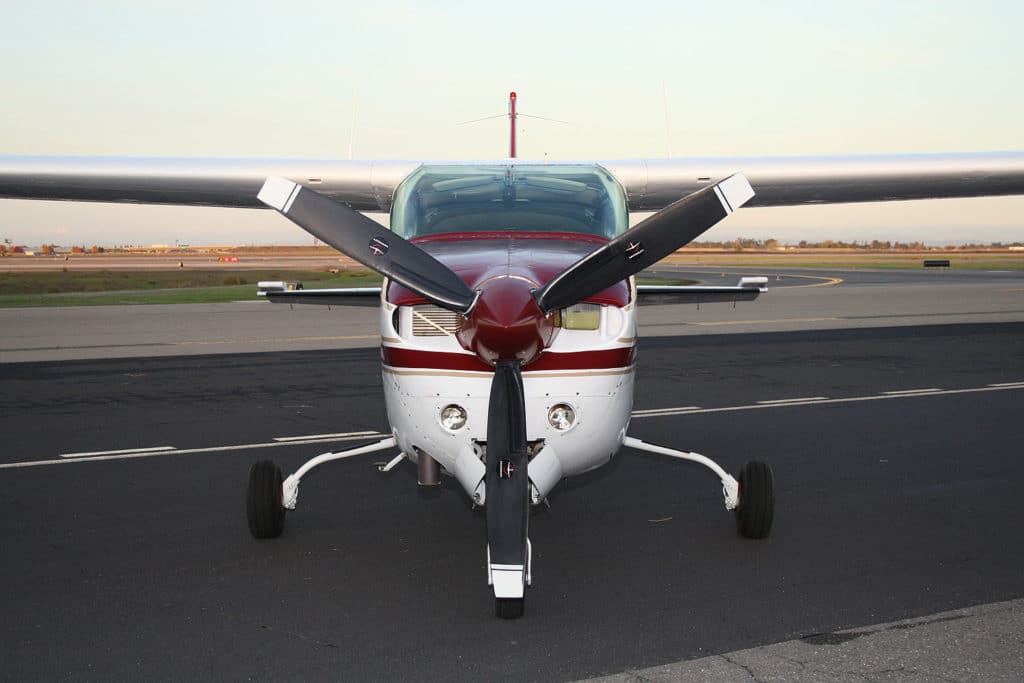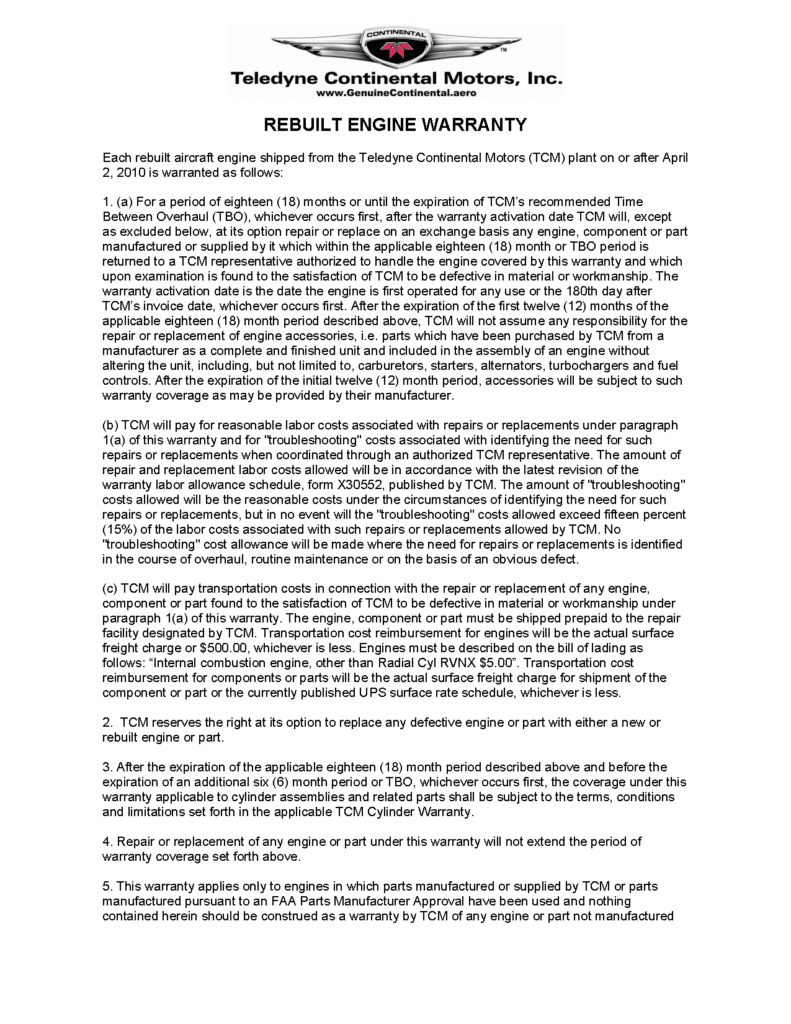You bought a $40,000 engine, and it turns out to be a lemon. That’s okay, you’re covered under warranty, right? Hmmm…
On a breathtakingly beautiful spring day in April 2011, one of my clients landed his 1980 Cessna T210 at its home base—a high-altitude airport (5,000 feet MSL) surrounded by 10,000-foot mountainous terrain in all quadrants—and taxied to his tee-hangar. While pushing the airplane into the hangar, the owner noticed some oil leaking from the bottom of the engine cowling, and brought it to the attention of a local A&P. The mechanic inspected the engine—a Continental TSIO-520-R—and said the oil seemed to be leaking from the rear cover of the engine’s starter adapter where the shaft for the alternator drive pulley emerges.

The mechanic washed down the engine with solvent and had the owner do a thorough engine runup. Oil was now found to be leaking from the area around the starter adapter shaft in copious quantities. The shaft itself seemed to be off-center in the boss on the rear cover of the starter adapter, and exhibited excessive free play. An overhauled/exchange starter adapter was ordered from Niagara Air Parts with next-day-air shipping. Meantime, the mechanic pulled the engine’s oil filter, cut it open, and found a substantial quantity of ferrous metal.
That’s when the owner contacted me.
A troubled history
My review of his aircraft’s maintenance records revealed that this engine had a troubled history. It started in late 2007 when the owner decided to replace the engine. There was nothing really wrong with the previous engine, but it was approaching TBO and the owner decided that “it was time.” (Had he been my client at the time, I’d have done my best to convince him to keep flying the engine rather than replacing it, as I’m definitely not a believer in the concept of TBO for piston aircraft engines—but he wasn’t and so I didn’t.)
To minimize downtime, the owner decided to purchase an overhauled/exchange TSIO-520-R engine from one of the biggest and most reputable engine overhaul shops in the country. This company has a longstanding and well-deserved reputation for building excellent engines and standing behind them with a generous warranty policy and top-notch customer service. The replacement engine was shipped in late October 2007 and installed in the T210N in early December 2007, along with a new turbocharger, turbo controller and wastegate assembly.
In April 2009—just 16 months and 154 hours later—a substantial quantity of ferrous metal was found in the oil filter during a routine oil change. Further investigation revealed damage to the oil pump gears. The engine was removed from the aircraft and shipped to the shop that built the engine for evaluation. The engine shop performed a complete teardown inspection, installed new main and rod bearings, new rod bolts and nuts, and a new oil pump. They flushed the oil cooler, turbocharger, lifters, wastegate, starter adapter and turbo controller, and installed an overhauled propeller governor. The engine was shipped back to the owner in early June, and reinstalled in the aircraft in early August. This work was covered under warranty.
Three months later in November 2009—at 203 hours SMOH and 48 hours after the teardown—problems developed with the turbocharging system, resulting in replacement of the turbo controller. At that time, the oil filter was found to contain a small but appreciable quantity of ferrous metal, but after consultation with the engine shop it was decided to continue the engine in service.
All appeared to be fine with the engine until that beautiful spring day in April 2011—at 325 hours and 42 months SMOH, and 189 hours and 24 months since the teardown—when the engine developed a massive oil leak at the starter adapter shaft boss, a substantial quantity of ferrous metal was found in the oil filter, and the owner called me.
Now what?
I asked the local mechanic to send the contaminated oil filter media to Aviation Laboratories in Kenner, Louisiana for scanning electron microscope (SEM) evaluation, and also to pull the propeller governor and inspect the gasket screen for the presence of metal. The mechanic reported that the prop governor screen was clean, suggesting that in all likelihood the filter caught all of the metal and the main and rod bearings were probably not contaminated.
The SEM report came back from Aviation Laboratories, and said that the filter contained “a large quantity of steel flakes compliant with Aerospace Materials Specification AMS 6730” and suggested that the most likely source of this metal was from “camshaft lobes.” This was a bit unexpected, as up until that point we all assumed that the metal in the filter was from the damaged and leaking starter adapter.
The owner then contacted the engine builder and explained the whole situation. The engine shop recommended that the owner have his mechanic replace the starter adapter with the overhauled one from Niagara Air Parts—a procedure that the mechanic said would require hoisting the engine off its mounts and moving it at least four inches forward to provide adequate access—and then fly the airplane for five hours and re-check the oil filter for metal.
The owner and I discussed the engine builder’s recommendation at length. The owner was not comfortable with the recommendation for two reasons: First, the SEM report suggested that the metal in the filter was most likely coming from a disintegrating cam lobe, not from the starter adapter. Second, the aircraft was AOG at a high-altitude airport with treacherous mountainous terrain in all directions—not exactly the ideal location for flight testing a single-engine airplane with a sick engine. I could not fault the owner’s reasoning one bit.
Ultimately a decision was made to pull the engine and ship it back to the engine builder for another teardown inspection. Weeks later, the engine shop reported that the engine had been torn down, and (as feared) the starter adapter was damaged and the camshaft was unserviceable. Now the real fun began…
Who pays?
At my suggestion, the owner told the engine shop that due to its extraordinary history of making metal, he had completely lost faith in this particular engine, and wanted the shop to provide him with another freshly overhauled replacement engine at an 80% discount, since the current engine had been in service for only 325 hours (just 20% of its 1600-hour TBO).
The engine shop said it would be happy to sell the owner another engine, but could offer only a 21% discount—nowhere close to the 80% discount that the owner was seeking. The shop explained that its engine warranty provides 100% coverage (parts and labor) for one year or 500 hours (whichever comes first), after which partial coverage is provided on a pro-rata basis to TBO at an accrual rate of 30 hours per month starting at the engine delivery date.
Since the engine was delivered in November 2007 and the starter adapter problem surfaced in April 2011, the engine had been in service for 42 months for warranty purposes. Under the terms of the warranty, the engine had accrued 1260 hours (42 months at 30 hours/month) or 79% of its 1600-hour TBO. Consequently, the engine shop’s warranty obligation is only 21%.
(Note that this engine shop’s warranty is still relatively generous by industry standards. In my experience, most engine shops prorate their warranties at 40 hours per month.)
What about factory engines?
At this point, you might be asking yourself whether this owner would have been better off buying a factory engine—rebuilt or new—instead of one overhauled by an engine shop. I wondered about that myself, and it turns out the answer is “no.” In fact, had the engine in question been a factory engine, the owner would have been entitled to no warranty consideration at all.

Continental rebuilt engines shipped on or after April 2, 2010, are warranted for a period of 18 months or TBO, whichever occurs first. (Three guesses which one always occurs first?) Prior to April 2, 2010, they were warranted for 12 months. Continental new engines are warranted for a period of 24 months or TBO, whichever occurs first. Beyond this initial period, there is no extended pro-rata warranty to TBO at all. Once the initial 12-, 18-, or 24-month warranty period expires, you’re on your own.
To make things slightly more complicated, Continental limits its warranty on engine accessories (alternators, carburetors, starters, turbochargers, fuel controls, etc.) to 12 months on all factory engines, whether rebuilt or new. On the other hand, cylinders are warranted for 24 months on all factory engines. The warranties also exclude coverage for engines damaged by corrosion, detonation, pre-ignition, and various other conditions, and engines that have been modified by the addition of such things as aftermarket intercoolers or turbonormalizers.
Lycoming’s engine warranty is simpler. All Lycoming factory engines, whether new or rebuilt, are warranted for 24 months. There is no extended pro-rata warranty to TBO. There are exclusions for aftermarket modifications and factory engines that have been repaired with aftermarket parts.
Warranty Schmarranty!
Consider that the average owner-flown piston aircraft flies less than 100 hours a year. This means that for most owners, the warranty on Lycoming and Continental factory engines provide coverage for only the first 100 to 200 hours (which represents only 5% to 10% of TBO). Field overhaul shops may provide some extended warranty coverage prorated to TBO, but for most owners the accrual rates of 30 to 40 hours per month result in relatively little coverage beyond the first year or two.
In my experience, expensive engine problems often start showing up when the engine has 400 to 600 hours. By then, for most owners, that’s 4 to 6 years by which time there’s no warranty left regardless who built the engine.
You bought a plane to fly it, not stress over maintenance.
At Savvy Aviation, we believe you shouldn’t have to navigate the complexities of aircraft maintenance alone. And you definitely shouldn’t be surprised when your shop’s invoice arrives.
Savvy Aviation isn’t a maintenance shop – we empower you with the knowledge and expert consultation you need to be in control of your own maintenance events – so your shop takes directives (not gives them). Whatever your maintenance needs, Savvy has a perfect plan for you: